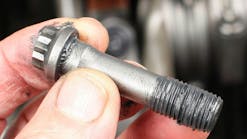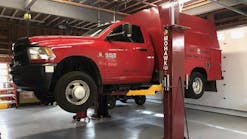8 tips to make your shop successful with inventory management
For a shop owner, inventory management is essential to ensure that your auto repair shop has the necessary parts and tools to complete repairs efficiently and effectively. Implementing an inventory management system in an auto repair shop can be complex, but several steps can help ensure success. An accurate inventory system with effective management allows parts usage to be more responsive to your operational demands.
What is inventory management?
Inventory management is the process of overseeing and controlling the inventory of a business and includes the purchase, storage, and use of materials, parts, and products. The goal of inventory management is always to maintain the right inventory level so that the business can operate efficiently and effectively. Executed properly, it can help streamline inventories to avoid stock overages, helping you identify how much stock to order and when. Parts inventory management is a balancing act of spending resources on the right mix of parts and supplies and minimizing the risk of overstocking surplus goods while securing the parts that add value.
Why auto repair shops need inventory management systems
Let's explore why auto repair shops need an inventory management system and how a good system can impact your workflows and overall efficiency.
Improves Workflow
Effective inventory management system designs improve the workflow of an auto repair shop by ensuring that the right parts and tools are available at the right time. For example, when a technician must stop working on a vehicle to search for a part or tool, this can cause delays and decrease productivity. With an inventory management system, parts and tools are tracked and stored in an organized manner, making it easier to locate them quickly when needed. This helps to keep the workflow moving smoothly and ensures that customers are not left waiting for long periods.
Increases Efficiency
An inventory management system can help increase efficiency by automating many of the processes involved in inventory management. For instance, when inventory levels are low, the system can generate alerts, notifying the manager to order new parts. This can help reduce the risk of stockouts, ensuring that the necessary parts are always available. Additionally, an inventory management system can help track inventory usage, which can help managers identify trends and optimize their inventory levels accordingly.
Reduces Waste
Auto repair shops often deal with a wide range of parts and tools only used for specific vehicles. This can lead to overstocking and waste if the parts are not used within a specific timeframe. With an inventory management system, auto repair shops can track the usage of parts and tools, only ordering what they need, thus reducing waste, obsolescence, and unnecessary expenses.
Improves Accuracy
Manual inventory management can be prone to errors, such as misplacing parts or ordering the wrong parts. An inventory management system significantly reduces the risk of these errors. The system can track inventory levels and usage, making it easier to reorder parts when needed. This ensures that the correct parts are always available, leading to more accurate repairs and increased customer satisfaction. Improving accuracy will result in your team spending less time looking for parts and more time completing tasks that focus on improving the operations of your business and increasing profits. Does internal shrinkage sound familiar? An inventory management system will help you identify inventory that slips through the cracks and fails to make it on the repair order.
Better Customer Service
Customer service is essential to any business, and auto repair shops are no exception. Customers expect quality repairs to be completed within a reasonable timeframe. With an inventory management system, auto repair shops can ensure that the necessary parts and tools are always available, reducing repair times and improving customer satisfaction.
Employ these 8 tips:
1. Conduct regular inventory audits
It's important to know what parts and tools you have in stock at all times. Conducting regular audits of your inventory will help you identify any discrepancies and ensure that you have accurate records. Conducting bin or shelf checks is a simple task. Assign team members the responsibility of counting or spot-checking a small number of what you consider the fast-moving parts each week or at least once per month.
2. Use inventory management software
Many inventory management software programs can help you track your inventory, automate reordering, and generate reports. These tools can save time and reduce the likelihood of errors. For example, consider using a barcode inventory system that you synchronize with a management system.
3. Categorize your inventory
Categorizing your inventory can help you quickly locate the parts and tools you need. You can categorize by type of part or tool, manufacturer, or even by the make and model of the car.
4. Set par level
Par levels, or periodic automatic replacement, are the minimum quantities of parts and tools you should always have in stock. By setting par levels, you can ensure you always have the parts and tools you need on hand.
5. Monitor your sales
Tracking your sales can help you identify which parts and tools are most in demand, which can help you make more informed purchasing decisions.
6. Build relationships with suppliers
Building strong relationships with multiple suppliers can help ensure that you get the parts and tools you need in a timely manner. Minimizing wait time for technicians and improving customer satisfaction.
7. Train your team
Make sure you train your team on inventory management processes and procedures. Training helps reduce errors and ensure everyone is on the same page when managing inventory. You can't expect your team to follow processes and procedures dealing with parts management if they are not properly trained to do so.
8. Implement a parts receiving process
Check all parts deliveries and shipments upon arrival, received items versus invoice – cross-check part numbers and quantity. Suppliers and delivery drivers can make mistakes; immediately spotting an error will prevent the possibility of the wrong parts getting to the technician, impacting productivity. Likewise, verify the correct parts arrive in the right quantity.
Inventory management is a critical aspect of your auto repair shop's operations. When done right, your customers will trust your shop to provide the services and tools needed to fix their problem. In addition, the inventory management system will improve workflow, increase efficiency, reduce waste, improve accuracy, provide better customer service, control costs, manage vendor relationships, and generate valuable insights through reporting and analytics. By implementing an inventory management system, auto repair shops can streamline their operations, increase profitability, and ensure they provide high-quality services to their customers.



